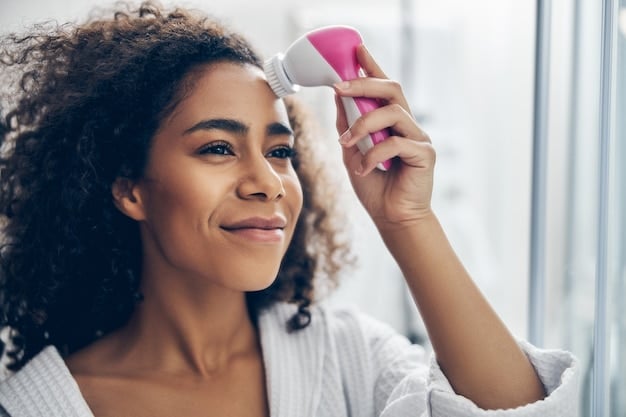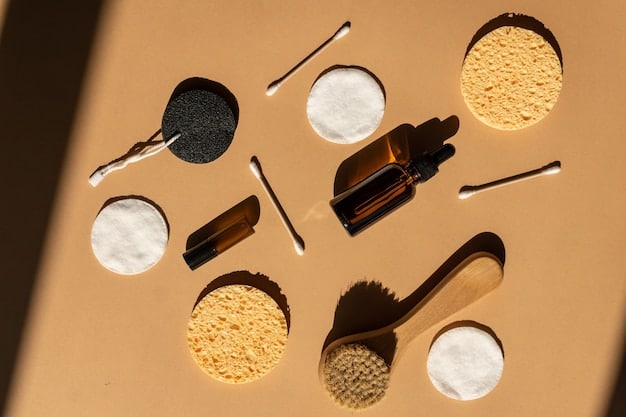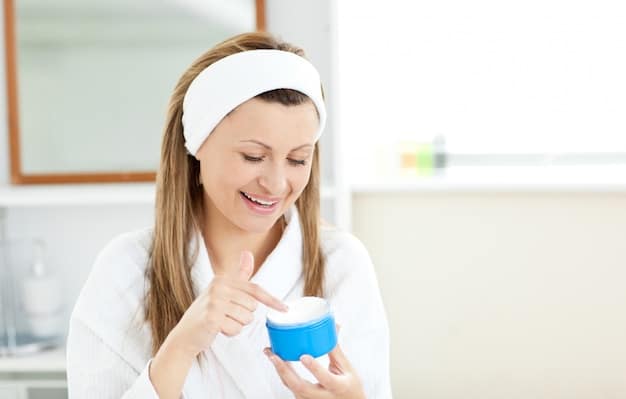Exfoliation Essentials: A Guide to Glowing Skin Without Overdoing It

Exfoliation is key to radiant skin, but overdoing it can cause irritation; learn how to incorporate it properly into your skincare routine for the best results, balancing effectiveness with gentleness.
Unlock the secret to radiant, healthy skin with exfoliation essentials: how to incorporate it into your skincare routine without overdoing it. Achieve a glowing complexion while avoiding irritation and damage.
Understanding exfoliation: what it is and why it matters
Exfoliation is a fundamental skincare process that involves removing dead skin cells from the surface of your skin. This practice not only enhances your skin’s appearance but also improves its overall health.
The skin naturally sheds dead cells, but this process can slow down due to factors like age, sun exposure, and environmental pollutants. When dead cells accumulate, they can clog pores, leading to acne, dullness, and uneven texture.
The benefits of exfoliation for your skin
Exfoliation offers numerous benefits. Not only does it improve the skin’s texture and tone, but it also prepares it for better absorption of skincare products. Regular exfoliation can promote cell turnover, leading to a brighter and healthier complexion.
- Removes dead skin cells to reveal brighter skin.
- Helps unclog pores to prevent acne breakouts.
- Improves skin texture and tone, reducing dullness.
- Enhances the absorption of serums and moisturizers.

Types of exfoliation: mechanical vs. chemical
There are two primary types of exfoliation: mechanical and chemical. Mechanical exfoliation involves physically removing dead skin cells using tools or abrasive scrubs, while chemical exfoliation uses acids or enzymes to dissolve the bonds between skin cells.
Mechanical exfoliation can be achieved with products like scrubs, brushes, or sponges. Chemical exfoliation involves using products containing alpha-hydroxy acids (AHAs) or beta-hydroxy acids (BHAs).
In conclusion, understanding the importance of exfoliation and its various types is essential for incorporating it effectively into your skincare routine. Choosing the right method based on your skin type and concerns can lead to significant improvements in your skin’s health and appearance.
Choosing the right exfoliant for your skin type
Selecting the appropriate exfoliant for your skin type is essential to prevent irritation and achieve the best results. Each skin type—oily, dry, sensitive, or combination—requires a different approach to exfoliation.
Understanding your skin’s needs and reactions to different products will help you avoid over-exfoliation and maintain a healthy skin barrier. The right exfoliant can transform your skin, while the wrong one can cause redness, dryness, and breakouts.
Exfoliants for oily and acne-prone skin
Oily and acne-prone skin types often benefit from chemical exfoliants like salicylic acid (BHA). Salicylic acid is oil-soluble, allowing it to penetrate pores and dissolve sebum and dead skin cells. This can help prevent breakouts and reduce inflammation.
Glycolic acid (AHA) is also effective for oily skin as it promotes cell turnover and reduces the appearance of acne scars. However, it’s important to use these acids in moderation to avoid over-drying the skin.
Exfoliants for dry and sensitive skin
Dry and sensitive skin types require gentler exfoliants. Lactic acid (AHA) is a milder option that provides effective exfoliation without causing excessive dryness or irritation. Enzyme exfoliants derived from fruits like papaya and pineapple are also suitable for sensitive skin.
- Lactic Acid: A gentle AHA suitable for dry and sensitive skin.
- Enzyme Exfoliants: Derived from fruits, providing mild exfoliation.
- Gentle Scrubs: Use sparingly with fine, round particles to avoid micro-tears.
Exfoliants for combination skin
Combination skin types may require a combination of different exfoliants to address varying needs. You can use a BHA product on oilier areas and a gentler AHA or enzyme exfoliant on drier areas. Patch testing new products is always recommended to monitor your skin’s reaction.
In conclusion, choosing the right exfoliant involves understanding your skin type and its specific needs. Opting for gentle formulations and monitoring your skin’s response will help you achieve a balanced and healthy complexion without causing irritation.
How to incorporate exfoliation into your routine: a step-by-step guide
Incorporating exfoliation into your skincare routine requires a thoughtful approach to maximize benefits and minimize potential irritation. A consistent yet gentle strategy is essential for maintaining healthy, glowing skin.
Starting slowly and paying attention to how your skin responds is crucial. This step-by-step guide will help you introduce exfoliation effectively and safely into your regimen.
Start slow: exfoliating frequency
Begin by exfoliating once or twice a week to allow your skin to adjust. Over-exfoliating can lead to redness, dryness, and increased sensitivity. As your skin becomes more tolerant, you can gradually increase the frequency.
For sensitive skin, once a week may be sufficient. Oily or acne-prone skin may benefit from exfoliating two to three times per week. Always monitor your skin for signs of irritation.
Morning vs. evening exfoliation
Whether you exfoliate in the morning or evening depends on your personal preference and routine. Exfoliating in the evening allows your skin to benefit from overnight repair and hydration. Morning exfoliation can brighten the skin and prepare it for makeup application.
- Evening: Allows for overnight repair and hydration.
- Morning: Brightens skin and preps for makeup application.
- Listen to Your Skin: Adjust timing based on sensitivity and routine.
Layering with other skincare products
When incorporating exfoliation, be mindful of how it interacts with other products in your routine. Avoid using strong actives like retinol or vitamin C on the same night as exfoliation to prevent over-stimulation. Always apply hydrating and soothing products after exfoliating to replenish the skin’s moisture barrier.

In conclusion, incorporating exfoliation requires a gradual and mindful approach. Starting slow, choosing the right time, and layering with hydrating products will ensure you achieve radiant skin without causing irritation or damage.
Recognizing the signs of over-exfoliation and how to treat it
Over-exfoliation can damage your skin’s protective barrier, leading to a host of issues. Recognizing the signs early is crucial to preventing long-term damage and restoring your skin’s health.
Understanding what to look for and how to respond can help you maintain a balanced skincare routine and avoid unnecessary irritation. Being proactive about treating over-exfoliation is essential for a healthy complexion.
Common signs of over-exfoliation
Common signs of over-exfoliation include redness, irritation, dryness, and increased sensitivity. You might also experience breakouts, inflammation, and a compromised skin barrier. Pay attention to these warning signs and adjust your routine accordingly.
If your skin feels tight, itchy, or looks shiny with a plastic-like appearance, you may be over-exfoliating. Increased sensitivity to other skincare products is another indicator.
Immediate steps to take when you’ve over-exfoliated
If you notice signs of over-exfoliation, immediately stop using all exfoliating products. Focus on hydrating and calming your skin with gentle, soothing ingredients. Avoid harsh cleansers and active ingredients until your skin recovers.
- Stop Exfoliating: Immediately halt all exfoliation.
- Hydrate: Use gentle, hydrating serums and moisturizers.
- Protect: Apply sunscreen daily to protect sensitive skin.
Repairing your skin barrier
To repair your skin barrier, incorporate products containing ceramides, hyaluronic acid, and natural moisturizing factors (NMFs). These ingredients help restore the skin’s natural moisture balance and protect it from environmental stressors. Avoid using harsh chemicals or fragrances that can further irritate your skin.
In conclusion, recognizing and addressing over-exfoliation promptly is essential for maintaining healthy skin. By identifying the signs, taking immediate action, and focusing on barrier repair, you can restore your skin’s health and prevent long-term damage.
Maintaining balance: finding the right exfoliation frequency for long-term results
Finding the right balance in your exfoliation routine is key to achieving long-term results without damaging your skin. Over-exfoliating can lead to irritation and sensitivity, while under-exfoliating may not provide the desired benefits.
Personalizing your approach based on your skin type, environment, and skincare goals is crucial for maintaining a healthy and radiant complexion. Understanding your skin’s specific needs will guide you in establishing an effective and sustainable exfoliation schedule.
Factors that affect exfoliation frequency
Several factors can influence how often you should exfoliate. These include your skin type, the type of exfoliant used, climate, and your skin’s overall condition. Individuals with oily skin may tolerate more frequent exfoliation, while those with dry or sensitive skin may need to exfoliate less often.
Harsh climates can also affect your skin’s sensitivity, so adjust your exfoliation frequency accordingly. Monitor how your skin responds and make adjustments as needed.
Adjusting your routine seasonally
Your skin’s needs change with the seasons. In colder months, skin tends to be drier and more sensitive, so reducing exfoliation frequency and focusing on hydration can help maintain a healthy barrier. In warmer months, increased oil production may warrant more frequent exfoliation. Adjust your routine to meet your skin’s seasonal demands.
- Winter: Reduce frequency, focus on hydration.
- Summer: Increase frequency if oil production rises.
- Listen to Your Skin: Adapt based on your skin’s needs.
Long-term benefits of balanced exfoliation
A balanced exfoliation routine offers numerous long-term benefits, including improved skin texture, reduced breakouts, and enhanced radiance. Regular exfoliation can also help prevent signs of aging and promote overall skin health. By finding the right balance, you can enjoy these benefits without compromising your skin’s integrity.
In conclusion, maintaining balance in your exfoliation routine is vital for long-term skin health. By considering various factors, adjusting your routine seasonally, and observing your skin’s response, you can achieve a radiant and healthy complexion while avoiding the pitfalls of over-exfoliation.
Product recommendations: gentle exfoliants for daily or regular use
Selecting the right exfoliant products is essential for maintaining a balanced skincare routine. Gentle exfoliants designed for daily or regular use can help improve skin texture, clarity, and radiance without causing irritation.
These products often contain mild acids, enzymes, or fine particles that gently remove dead skin cells. Incorporating these into your regimen can lead to smoother, healthier-looking skin.
Enzyme cleansers and masks
Enzyme cleansers and masks are excellent options for gentle exfoliation. These products use enzymes from fruits like papaya and pineapple to dissolve dead skin cells without harsh abrasion. They are suitable for all skin types, including sensitive skin.
Look for products with ingredients like papain and bromelain for effective yet gentle exfoliation. Use these cleansers or masks 1-3 times per week for best results.
Mild AHA/BHA toners and serums
Mild AHA/BHA toners and serums can provide gentle chemical exfoliation. These products typically contain low concentrations of acids like lactic acid, glycolic acid, or salicylic acid. They help to improve skin texture and tone without causing significant irritation.
- Lactic Acid Toners: Gentle exfoliation for sensitive skin.
- Salicylic Acid Serums: Clears pores for acne-prone skin.
- Glycolic Acid Pads: Improve texture and tone.
Physical exfoliants: micro-exfoliating cloths
Micro-exfoliating cloths are a gentle way to physically exfoliate the skin. These cloths have a soft, textured surface that gently buffs away dead skin cells. They are a good option for those who prefer physical exfoliation but want to avoid harsh scrubs.
In conclusion, incorporating gentle exfoliants into your daily or regular routine can significantly improve your skin’s health and appearance. By choosing the right products and using them as directed, you can achieve a radiant and smooth complexion without causing irritation or damage.
| Key Point | Brief Description |
|---|---|
| ✨ Exfoliation Basics | Removes dead skin cells for brighter skin. |
| 🧪 Choosing Exfoliants | Select based on skin type: oily, dry, sensitive. |
| 🗓️ Frequency Tips | Start slow: 1-2 times a week. Adjust as needed. |
| 🚨 Over-Exfoliation | Recognize signs and hydrate to repair the skin. |
FAQs About Exfoliation
▼
The main benefit of exfoliation is the removal of dead skin cells, which reveals brighter, smoother skin and allows for better absorption of skincare products.
▼
Exfoliating every day is generally not recommended, as it can lead to over-exfoliation and irritation. Gentle exfoliants can be used more frequently, but always monitor your skin’s response.
▼
Signs of over-exfoliation include redness, irritation, dryness, increased sensitivity, breakouts, and inflammation. It’s essential to recognize these signs and adjust your routine accordingly.
▼
For sensitive skin, gentle exfoliants like lactic acid, enzyme exfoliants (from papaya or pineapple), or very mild physical exfoliants are best. Always patch test new products.
▼
To repair your skin after over-exfoliating, stop all exfoliation, use hydrating and soothing products containing ceramides and hyaluronic acid, and protect your skin with sunscreen.
Conclusion
Mastering the art of exfoliation involves understanding your skin’s unique needs and striking a balance between effectiveness and gentleness. By choosing the right exfoliants, incorporating them thoughtfully into your routine, and recognizing the signs of over-exfoliation, you can unlock a radiant and healthy complexion without compromising your skin’s natural barrier.





